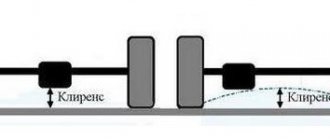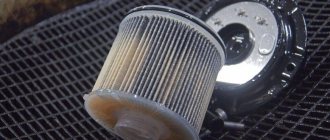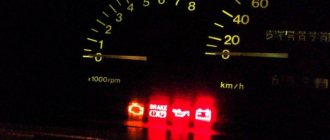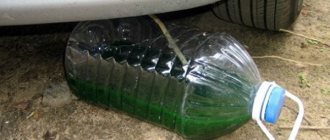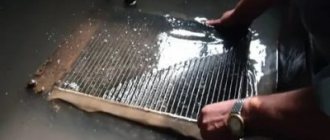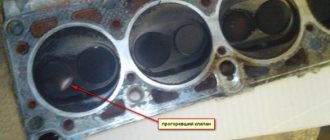Almost all motorists living in regions with harsh climates have encountered the problem of starting the engine in cold weather. This problem is especially relevant for people who do not have a garage, since it is much more difficult to start a car that is parked in the open frosty air.
In this article you will find tips that will make starting the engine easier, you will learn how to start the engine in cold weather and what to do if the car does not start.
You should also be aware that operating a car at low ambient temperatures (less than -15 degrees Celsius) has a negative impact on the condition of your car. In extreme cold (25–40 degrees below zero), I strongly do not recommend using a car, as wear on the chassis increases tenfold. This is due to the fact that at low temperatures oils and lubricants largely lose their beneficial properties.
How to make engine starting easier
If you have difficulty starting the engine in cold weather, then take note of the following recommendations:
1. Replace the engine oil with winter oil. For example, for synthetic with a viscosity of 5w (up to -30 degrees), or better yet 0w (up to -35 degrees). This oil is less thick, so it will practically not interfere with the rotation of the crankshaft. This will greatly facilitate starting the engine.
However, you should not use such oil in old engines and in the engines of some domestic cars. The fact is that synthetic oil is very liquid; it can leak through worn or poor-quality oil seals.
If synthetic oil is consumed in your engine, then you can try using semi-synthetic oil.
Conclusion: In winter, you should use oil with a minimum viscosity suitable for your engine (the oil should not be wasted);
2. Take care of the condition of the battery (it is better to bring it home at night, since a warm battery releases much more energy), clean the oxidized terminals. If the battery is weak, then starting the engine in cold weather is almost impossible; the crankshaft simply will not turn (in this case, you should charge the battery before starting the engine).
You can purchase a battery with a larger capacity (the main thing is that it fits in size), since imported cars have weak batteries that are not designed for operation in cold climate zones. Using such a battery will not cause any particular harm, only the work of the brush-commutator assembly of the starter and generator will be more intense.
3. If possible, park your car in a garage. It doesn’t matter what kind of garage: metal or brick. The garage is usually 5-10 degrees warmer, and this plays a very important role when starting the engine;
4. Check the condition of the spark plugs. If the spark plugs are worn out or of poor quality, starting the engine becomes difficult. Since during a cold start, a mixture richer in fuel is supplied to the cylinders, this can negatively affect spark formation;
5. Various heating devices can be installed. For example, an engine coolant heater (2000–4000 rubles with installation, usually powered by an electrical network).
It crashes into pipes with antifreeze (or antifreeze). When using such devices, the engine starts without problems, since the warm coolant heats up the entire engine.
Advice from experienced drivers
Even if the car owner does not often drive the car at low ambient temperatures, it is recommended to pay a minimum of attention to the car and warm up the engine at least every other day.
Important: In severe frosts, it is recommended to refuel a vehicle with an automatic transmission with fuel with a higher octane number. You can also use special fuel additives that help gasoline ignite faster.
Before directly turning on the engine, it is recommended to turn on the car's headlights for 10 seconds. During this period, the electrolyte has time to warm up thoroughly to help the starter.
- If the garage is unheated or the car is left to spend the night in the open air, it is best to remove the battery from the car during winter frosts and store it in a warm room.
- The number of attempts to start the engine should not exceed three times. Otherwise, the battery will be completely discharged.
- The use of a special charging and starting device - a booster - can also come to the rescue.
- After starting the engine, it is recommended to wait at least 10 minutes for the internal combustion engine, heater, transmission oil, and automatic transmission to warm up. Only after all systems and units have warmed up can the load on the power unit be increased.
Attention: It is strictly forbidden to start a car with an automatic transmission using a pusher. This will lead to complete failure of the working elements of the automatic transmission and the entire transmission of the car. To send an unstarted car to a service center, it is best to use the services of a tow truck. If this is not possible, you need to put the gear selector in the neutral (N) position and tow the car to the nearest service station, located no further than 30 km.
How to start the engine
First of all, you need to warm up the battery. To do this, turn on the low beam headlights for 20–30 seconds, but no more, otherwise the battery will be discharged. A heated battery, unlike a cold one, releases much more energy.
Then turn off all electrical appliances: heater fan, headlights, rear window defoggers, radio.
The oil in the gearbox has frozen, and the load on the starter increases greatly, which prevents the crankshaft from rotating. Therefore, if you have a manual transmission, be sure to press the clutch pedal to the floor. This will greatly facilitate the rotation of the shaft.
If your car is equipped with a carburetor engine, then pull out the choke and do not touch the gas pedal (this will fill the spark plugs).
Next, with the clutch pedal depressed, start starting the engine (attempts should not last longer than 15 seconds, the interval between attempts should be at least 20 seconds, otherwise the starter may be damaged).
If the engine starts to seize, it is very important not to turn off the starter; you must let the engine start completely.
When the engine starts, do not immediately release the clutch, wait 20 seconds, then smoothly release the pedal.
Weak battery
Reason : The battery may not hold a charge well due to age (more than 3 years), internal defects, or improper use.
Signs : the starter does not turn the engine at all or turns unstably, while the lights on the instrument panel are dim.
Solutions:
- If the battery somehow reacts to attempts to start the car, then you can try turning on the low beam headlights for a few seconds. This will help “wake up” the battery, and the next time you try, it will produce the required amount of energy.
- Check the battery terminals: dirt or oxidation will often cause poor contact. Cleaning them can restore normal current flow.
- Push start a car with a manual transmission.
- “Lighting up” from another car.
- If you have time, you can remove the battery and take it somewhere warm to warm it up.
- A radical measure is to install a new battery, preferably with a larger capacity.
Prevention:
- Remove the battery and take it to a warm place overnight (this is what most car owners in the Siberian and Ural regions do).
- Install a system that will monitor the engine temperature, and when it drops to a set level, the electronics can independently start the car and maintain the “operating” temperature.
What to do if the engine does not start
If the engine does not start after three or four attempts, then you should not hope that it will start the next time. In this case, other measures must be taken depending on the following situations:
- The starter is turned on, but the crankshaft barely rotates. Perhaps the battery power is not enough, in this case it needs to be charged, or lit from another car.
- The crankshaft rotates, the engine occasionally seizes, but does not start. Most likely you have flooded the spark plugs. It is necessary to blow out the cylinders and calcine the spark plugs. It is useless to try to start the engine with flooded spark plugs.
If all else fails, tow the car to a warm place (maybe a car wash). As soon as you drive the car into such a room, open the hood and let the car sit for one, or preferably two, hours. After that, feel free to start it. It is also possible that the car will not start, then you need to look for a fault (most often flooded spark plugs).
Everything works, but the spark plugs are flooded
Reason : the spark plugs are so dirty that the spark does not penetrate into the ignition chamber. Or, while other systems were not working, gasoline was supplied to the combustion chambers and “flooded” the candles, representing not an air mixture, but a liquid.
Signs : unscrewed spark plugs are completely covered with gasoline. It is better to check them before the battery is completely drained. The exhaust pipe smells of unburned gasoline.
Article on the topic
Cold protection. Review of winter car cosmetics
Solutions:
- If the situation has not reached a critical level, then you need to temporarily stop trying to start the engine. Wait a few minutes for the gasoline to drain. Turn the engine with the starter for a few seconds, fully depressing the gas pedal, to “ventilate” the cylinders and try again. The driest cylinders can “grab” and pull the rest with them.
- Cleaning spark plugs, calcining them or replacing them. Unscrewed spark plugs can be cleaned with a simple toothbrush and a modern cleaner. The main thing is not to get carried away and damage the insulating layer. You can heat the candles on the stove burner until you can’t pick them up with your hand. The hotter the spark plugs are when screwed into the engine, the better.
Prevention:
- When the car starts for the first time, you do not need to immediately press the gas pedal. Let it “seize” first in standard starting mode.
- Periodically check the performance of the glow plugs.
Scavenging
On vehicles with a fuel injection system, there is a cylinder purge mode. It is used to clean the engine cylinders of excess gasoline (for example, after several unsuccessful attempts to start the engine). This mode is activated when the throttle is opened more than 80% (the computer receives information from the throttle sensor) and the engine speed is less than 400 rpm. When the purge mode is activated, the computer will deplete the mixture to 1:20.
In other words, this mode is activated by pressing the gas pedal all the way. It cuts off the fuel supply to the engine cylinders.
I recommend using the purge mode when starting the engine in severe frost; in this case, the spark plugs should not be flooded.
I would like to add the following. When starting the engine, the saturation of the fuel mixture is determined by the computer depending on the engine temperature (from 1: 1.5 at -36°C to 1: 12 at +94°C).
To help the autonomous
One of the varieties of overhead heaters is called flexible heating plates. For the last ten years they have been massively imported from China.
Skeptics claim that according to the laws of physics, they are of no use, they only drain the battery. And they cite the example of the once widely advertised electric oil probes. There was no positive effect from them.
“I believe that flexible heating plates are a good type of electric heaters and they cope with their duties (again, provided they are connected to a 220 V household power supply).
When connecting to the vehicle's on-board network, you may find yourself in a situation where the oil in the crankcase is heated and the battery is discharged.
Even with the use of a battery discharge protection device, this type of connection is highly questionable for me, since flexible heating plates 12/24 V have a power of 100-150 W, which, in my opinion, is not enough for normal engine heating,” Alexander Stakanov doubts .
Meanwhile, there are already flexible plates with a power of 400 W on the market. They are capable of heating not only the oil in the engine crankcase, but also other places important for the operation of the equipment. True, for their operation, they again require a 220 V power supply.
Alexander Amelchenko, director of Kinovo LLC
“As for larger equipment, in the conditions of the Far North, before using flexible heating plates, it was necessary to use a huge diesel heat gun (flight attendant) for 24 hours.
Now workers use a diesel generator on the basis of a pickup truck and connect local heating of all components, thereby ensuring easy starting. This method of heating turned out to be much more profitable than traditional ones,” Alexander Amelchenko gives an example.
Flexible heating plates themselves are inexpensive. But if you take the necessary package, then the cost for one unit of equipment becomes comparable to a German autonomous liquid heater.
For example, for a small backhoe loader with an on-board 12V network, a comprehensive heating system from a 220V network will cost 25,040 rubles. It includes plates for heating the oil in the crankcase, fuel and hydraulic fluid in the corresponding tanks, as well as a cover for the battery.
Heating plate
If we add here the heating of the fuel line and fuel filter, the cost will increase by 7,180 rubles. For severe frost conditions, experts recommend installing a hydraulic reheating system after starting the engine, consisting of two plates with a total cost of 7,000 rubles.
For larger equipment with an on-board 24V network, they offer another comprehensive solution with a total cost of 48,540 rubles.
“Flexible heating plates are similar to the operating principle of a heating element, only in the case of a heating element plate, the entire surface of the tank with the heated liquid protrudes.
When using an external heater, the reservoir pan is evenly heated, the heat rises, thereby warming up the lower layer of liquid, which subsequently enters the pump.
The effectiveness of warming up the oil in this way has been proven by the short indication time of the oil pressure sensor on commercial vehicles. I note that flexible heating plates can safely heat various liquids due to the presence of built-in thermal contacts,” explains Mr. Amelchenko.
The Special Science of the Diesel Engine
Due to their operating characteristics and structural principles, diesel engines have their own operating conditions during low temperatures in winter. In practice, taking these operating principles into account, you can count on successfully starting a diesel engine in cold weather.
All the nuances of this type of engine lie within it, in its design features.
Firstly, it is diesel fuel. At a temperature of about 0 degrees, the paraffins that make up the fuel become gel-like, which becomes a barrier to its penetration into the engine itself.
Secondly, the method of ignition of the fuel mixture itself. Diesel fuel, unlike gasoline, where the ignition process occurs from a spark, ignites under high pressure. But at subzero temperatures, diesel fuel is unable to heat up and ignite.
Diesel injection systems
For a diesel engine, winter begins with a temperature of + 5 degrees and as it decreases, all problematic issues make themselves felt at startup.
To prevent this, it is necessary to change the fuel to winter fuel in time; there are three types of diesel fuel:
- summer - freezes at -5°C;
- winter – used up to -35°C;
- arctic – freezes at -55°C.
Preparation for winter, if you will frequently start the diesel engine in cold weather, should include:
- Checking compression pressure. If the compression indicator is less than 25 and the air temperature is below 20 degrees, then the car should not be left outside or needs to be warmed up.
- Checking the spark plugs. Glow plugs must provide the combustion chamber with the temperature necessary for the process of self-ignition and mixture formation. When preparing for winter starts, it is worth checking by connecting them to a power source; within 5 seconds they should glow, otherwise replacement is necessary.
Starting a diesel engine in winter
When starting a diesel engine in low temperatures in winter, first of all you need to check the condition of the battery and only then start starting. If it so happens that the engine does not start the first time, you need to calcine the glow plugs several times.
This is how a glow plug works
A reference light will be a light on the dashboard or a characteristic sound - the click of a relay. First, after warming up the glow plugs, you need to wait until the relay turns them off. Then turn off the ignition and, after waiting a while, about 15 seconds, repeat the same action. With this method, if your spark plugs are in good condition and the fuel is flowing properly, the engine should start.
If there are no problems with your engine, then you can use a special flammable aerosol. The use of such mixtures will help reduce the required temperature threshold for fuel ignition. They also contain additives that lubricate the parts and thereby eliminate dry cold friction at the time of start-up.
Errors when starting a diesel engine
And so, imagine, on a frosty winter morning you decide to start your car. Even if the car has undergone a full winter training program, it is necessary to adhere to a certain algorithm.
It is important to remember to warm up the battery and spark plugs. First of all, the biggest and most common mistake of car owners in this case is heating the battery with high beams, but this technique is only effective on a gasoline engine. Diesel behaves differently, and the best option is to turn on the ignition for a while, up to 15 seconds. This helps the battery and spark plugs warm up before starting.
Modern diesel cars very often have a system with a start-stop button. They have a special mode designed to warm up the glow plugs. In order to use it, you need to press the button without pressing the brake, usually 6 seconds is enough. After this, when the spark plug warm-up icon goes out on the instrument panel, your engine is ready to start.
You need to start the diesel engine with the clutch pedal depressed. At the same time, the starter turns the engine for 15 seconds. If the engine does not start, you can wait a few seconds and start again.
We do not recommend starting the car using a pushrod! Since modern diesel engines are very treacherous, you can not only break the timing belt, but bend the valves, damage the camshaft and all the ensuing consequences.
Therefore, take precautions and do not try homemade methods if you value your car and the time you will lose if it breaks down, not to mention your finances. It’s more important to be prepared for frosts in advance and then you won’t know what “won’t start” means!
Reasons for difficulty starting a car in cold weather
- The car is not mechanically prepared for winter. This is the most common reason, because most people repair the problem only after it has made itself felt. It is not right! You need to clearly understand the weaknesses of a car in winter and try to make these risks insignificant. Common problems include incorrectly set ignition, incorrect adjustment of the mixture driver (carburetor, injector, injectors), untimely replacement of consumables (fuel and air filters). It should be clearly understood that if there are even slight difficulties with starting in the summer, this will definitely come back to haunt you in the winter.
- Weak battery. This applies to a greater extent to old batteries that are more than 2 years old. Although, if used incorrectly, the battery may “age” faster. To understand the condition of the battery, you should contact a specialist. He will measure the condition with a special device and tell you how many working plates are in the battery and how long the full charge lasts. It will also measure whether the battery is fully charged from the generator. You may need to add electrolyte or distilled water for resuscitation.
- Wrong choice of oil . In winter, it is worth filling in oil marked 0W or 5W; this is a special oil for low temperatures. Withstands up to – 30 degrees. Also, prolonged use and untimely oil changes can lead to its thickening at low temperatures.
- Poor quality fuel. The cause of difficult starting is often poor quality fuel. With gasoline this is less noticeable, but with gas and diesel fuel it is more noticeable. For a diesel car, you need to buy winter diesel or add anti-gels to it (read about what anti-gel for diesel fuel is).
Is it necessary to warm up the engine?
This issue causes a lot of controversy among motorists. And if in summer you can still refrain from warming up, then in winter this operation is mandatory. Warming up the engine in cold weather will allow you to prepare all systems and mechanisms (take at least the same oil, which thickens as the temperature drops) for operation. But it needs to be done correctly. You should not turn on the cabin heater right away. This way you will spend a lot of time warming up. But turning on lighting fixtures and other “electrics” will be useful. This will increase the load on the generator and, accordingly, on the crankshaft. This way the engine will warm up to operating temperature faster and the battery will be fully charged.
Does the engine need to warm up for a long time? Experienced motorists do not recommend oiling the engine for 15-20 minutes or more. This is harmful to the engine. Five minutes of idling is enough for the engine to warm up to a minimum of +60 degrees. After this, you can move confidently. If the car is equipped with an automatic transmission, during this period (while the engine is idling) you should alternately switch all modes. This way we will heat up the ATP liquid in the box and preserve its resource.

